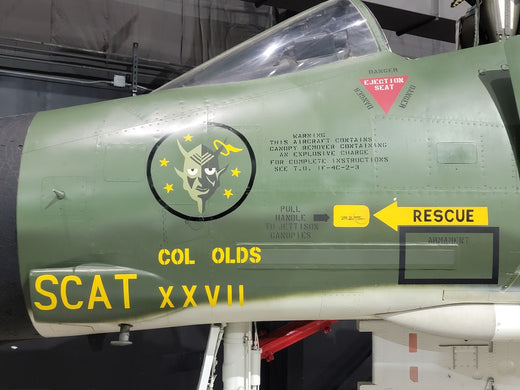This Fine Art Print by Artist Craig Tinder commemorates "Triple Ace", Col. Robin Olds and his double victory on 20 May 1967 during the Vietnam War. This Limited Edition Canvas Print includes a fragment from an AIM-7 Sparrow Missle Panel from an F-4 Phantom II and includes an engraved Certificate of Authenticity.
Details About the RELIC:
The relic fragment included with this art piece was once part of an aluminum slotted missile panel used to house the AIM-7 Sparrow missile beneath the forward belly of the F-4 Phantom II. The AIM-7 Sparrow, a radar-guided air-to-air missile, was a key component of the F-4 Phantom's arsenal, designed to engage enemy aircraft at medium to long ranges. Part number 32-31725-4, stamped on the panel, identifies its specific function and location on the aircraft. While the exact aircraft from which this artifact was salvaged is unknown, the panel was recovered before this particular aircraft was officially retired from service.
 "Tampa Zero One" F-4 Phantom canvas with actual F-4 relic (aircraft serial unknown)
"Tampa Zero One" F-4 Phantom canvas with actual F-4 relic (aircraft serial unknown)
As F-4 Phantoms were gradually phased out of active duty in the 1990s, parts such as this missile panel became increasingly rare, representing a piece of aviation and military history. This relic serves as a reminder of the technological advancements and the pivotal role the F-4 Phantom played during its decades of service in multiple air forces worldwide.
 Part number 32-31725-4 - F-4 Phantom slotted missile panel for the AIM-7 Sparrow Missle
Part number 32-31725-4 - F-4 Phantom slotted missile panel for the AIM-7 Sparrow Missle
 Markings on panel
Markings on panel
 Slotted Missile Panel on belly of F-4 Phantom
Slotted Missile Panel on belly of F-4 Phantom
 Artist, Craig Tinder, holding the slotted missile panel that is included as the relic in the "Tampa Zero One' limited edition prints
Artist, Craig Tinder, holding the slotted missile panel that is included as the relic in the "Tampa Zero One' limited edition prints
The Story Behind the Print:
On 20 May 1967, Colonel Robin Olds, one of the most celebrated fighter pilots in U.S. military history, led a daring mission during the Vietnam War. As the commander of the 8th Tactical Fighter Wing, flying under the call sign "Tampa 01," Olds led two flights of F-4C Phantom IIs to provide air cover for a wing of F-105 Thunderchief bombers targeting the heavily defended Kep airfield in North Vietnam. The mission was expected to encounter fierce opposition from North Vietnamese fighters, and the enemy did not disappoint.
 Col. Robin Olds
Col. Robin Olds
As Olds and his flight of eight F-4s arrived at their checkpoint, they were suddenly ambushed by 16 North Vietnamese MiG-17s. What followed was an intense 15-minute dogfight, one of the most dramatic air engagements of the Vietnam War. Despite being outnumbered two to one, Olds and his pilots skillfully maneuvered their F-4 Phantoms to take on the MiGs. In the chaos of battle, Col. Olds personally shot down two MiG-17s, marking a significant achievement in his already storied combat career. Despite the fierce opposition and heavy anti-aircraft fire, Olds and his wingmen managed to protect the F-105 bombers, allowing them to complete their bombing run on Kep airfield.
 Scat XXVII - Col Old's F-4 Phantom II - The artist visited this aircraft to take detailed notes for use in the creation of "Tampa Zero One"
Scat XXVII - Col Old's F-4 Phantom II - The artist visited this aircraft to take detailed notes for use in the creation of "Tampa Zero One"
Olds returned to base safely, though running dangerously low on fuel after the extended engagement. His actions on 20 May solidified his reputation as a fearless and highly skilled pilot. By the end of the Vietnam War, Olds had achieved four confirmed kills, adding to the 12 victories he had already scored during World War II, making him a triple ace across both conflicts.
Learn more about The F-4 Phantom’s Influence on Military Aviation Art in Mach Speed Muses? Click Here
To purchase or see similar items, visit here.
Commissioned by Museums, Treasured by Collectors





Share:
Collision Course, the story behind "Final Defense of 357"
Victory in the Skies, the story behind "Thunderhead of Precision"